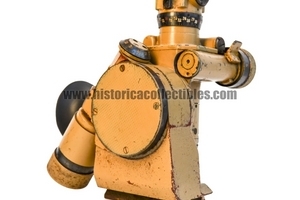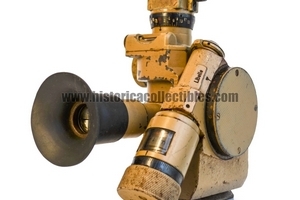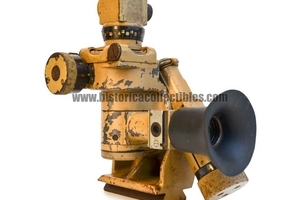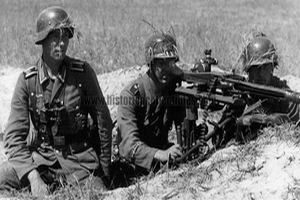Zieloptik CXN (Emil Busch) for Lafette MG42, circa 1942
Zieloptik (Targeting Optics) produced around 1942 by CXN, code name of the Emil Bush company of Rathenow (at the disposal of the Oberkommando der Wehrmacht) installed on the Lafette of the MG42 (Machine Gewehr).
The optic, extremely compact and functional, was designed to comply with the extraordinary ballistic characteristics with which the MG42 was equipped, which had a graduated elevation up to 2000 meters, but the fire could be carried out beyond 3500 meters thanks to the optic , which, equipped with a collimator and micrometric elevator, allowed the machine gunner to raise the lafette to the maximum range and carry out an extremely precise shot thanks also to the particular reticle with which the optic is equipped.
All the mechanisms work perfectly and its original Afrika-colored paintwork is intact, which concludes that it was used in East Africa by the DAK (Deutsche Afrika Korps) troops.
Complete with its original fully intact rubber eyecup.
Emil Busch was born on 6 August 1820 in Berlin and died in Rathenow on 1 April 1888 and was one of the most important German industrialists in the field of optics and precision mechanics. He was one of the proponents of the invention of the wide angle.
He was the son of the Berlin merchant Friedrich Ludwig Busch and his wife Jeanette, daughter of the entrepreneur Johann Heinrich August Duncker. In 1836 he moved with his family from Berlin to Rathenow. In 1840 Emil Busch returned to Berlin as an apprentice optician and mechanic. In 1845 he acquired the Industry Institute Optical from his uncle Edward Duncker. He equipped the factory with new machinery that he had partly built in his own mechanical workshop. The use of the new machines led to a significant increase in production data also because, thanks to the machinery, he was able to limit production times compared to manual work alone.
In 1852 he began the study and production of photographic lenses and in 1865 his first wide-angle lens "Pantoscop" was released. The founder of architectural photogrammetry Albrecht Meydenbauer exchanged views on the technical implementation of a camera which was equipped with the "Pantoscop" lens in 1867. In 1868 Busch was appointed "Königlichen Kommerzienrat" by the king for his services. In 1872 he transformed the company into a joint stock company in order to facilitate the investments necessary for growth. This happened thanks to the help of Vereinsbank Quistorp & Co. which brought the company's share capital to $275,000. In the company since then called Rathenower Optical Istituto Industriale ex Emil Busch A.-G. Emil Busch, held the very important position of "Delegate of the Supervisory Board" and was its director.
The company achieved a dominant role in the following period. Thanks to unofficial agreements with Zeiss he limited free competition. The name Emil Busch has always been synonymous with extreme quality in the optical field.








